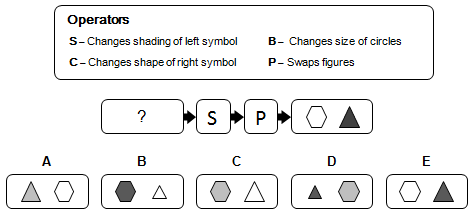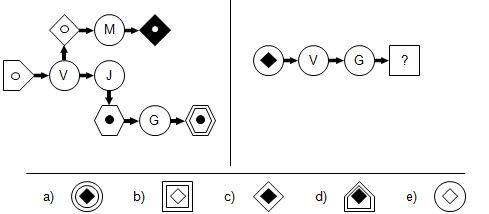Common Diagrammatic Reasoning Tests
The main aim of the diagrammatic reasoning tests is to assess mental reasoning abilities of an individual. In other words, the extent to which one can process data quickly and accurately. The below section will present some of the most common diagrammatic reasoning tests out there. It will provide example of both simple and advanced test questions alike. Good luck with your preparation.
Simple diagrammatic tests
Simple diagrammatic reasoning tests assume tests that consist of simple diagrams with inputs, outputs and operators. A good example to demonstrate this is presented in the figure below. As it can be seen flow chart is comprised of sequence with inputs, outputs and operators. Note that the effect of each operator is defined for you. That is, S changes the shading of left symbol whereas P swaps items. In the below diagram your task is to mentally process outputs with operators in order to define inputs. Allow yourself 30 seconds to inspect the diagram and mark the answer. Note that only one from five answer choices provided is correct. You may start working now.
 |
How did it go? Did you transform outputs to inputs correctly using the operators? Did you mark A as the correct answer? If yes then well done, you are grasping concept of diagrammatic reasoning tests. If not don't worry with more practice you will improve your skills. Note that in order to define inputs you need to start working backwards so if P swaps items and S changes shading of left item then input must be defined with gray triangle and white hexagon. Hence the correct answer must be A.
Note that simple diagrammatic reasoning flow charts mainly distinguish from advanced sequences by its defined operators where effect of each of the operators is defined for you. The below section will provide advanced example of flow chart where you have to find the effect of each operator.
Advanced diagrammatic tests
Advanced diagrammatic reasoning tests consist of flow charts where you will have to define outputs by means of inputs and operators or vice versa. In the same way as simple flow charts advanced process diagrams comprise series of inputs, outputs and operators presented in the form of letters, numbers or symbols. As you can see from the figure below the operators are marked with letters whereas inputs and outputs are presented as symbols. Your task is to determine what effect each of the operators is having on the input in order to produce output. Take no more than 60 seconds to mark the correct answer. You may start working now.
 |
How did it go? Note that in order to arrive at the correct answer you need to find out the effects of operators V and G. If you carefully inspect right side of the diagram you can see that the effect of V is to change the outer shape to different shape whereas the effect of G is to double the outer layer. Apply this to test item and you will find that the correct answer must be D.
Often, diagrammatic reasoning tests may incorporate numerical data coded in signs or symbols. In such assessments numerical value is assigned to each symbol. Numerical sequences in diagrammatic reasoning tests assess you logical reasoning aptitude along with your numerical aptitude.

